The period of the World War II (1939-1945) could be regarded as the darkest era in the panorama of the world history. It witnessed many uncivilized, beastly and brutal events in the history of the humankind like mass genocide, Holocaust, mass starvation, epidemics and first use of the nuclear weapons.
The events culminating in this period thwarted the growth of the globe on the whole and, almost, brought the world to a standstill. The period saw the most geographically widespread military conflict till date. The major belligerent countries were the Axis powers – Germany, Italy, and Japan; and the Allies – France, Great Britain, the United States and the Soviet Union.
One of the most important outcomes of the Second World War, inter alia, was that it extended the Soviet Union’s power to the states of Eastern Europe and shifted the power fulcrum from Europe to the US and the Soviet Union.
Causes of World War II
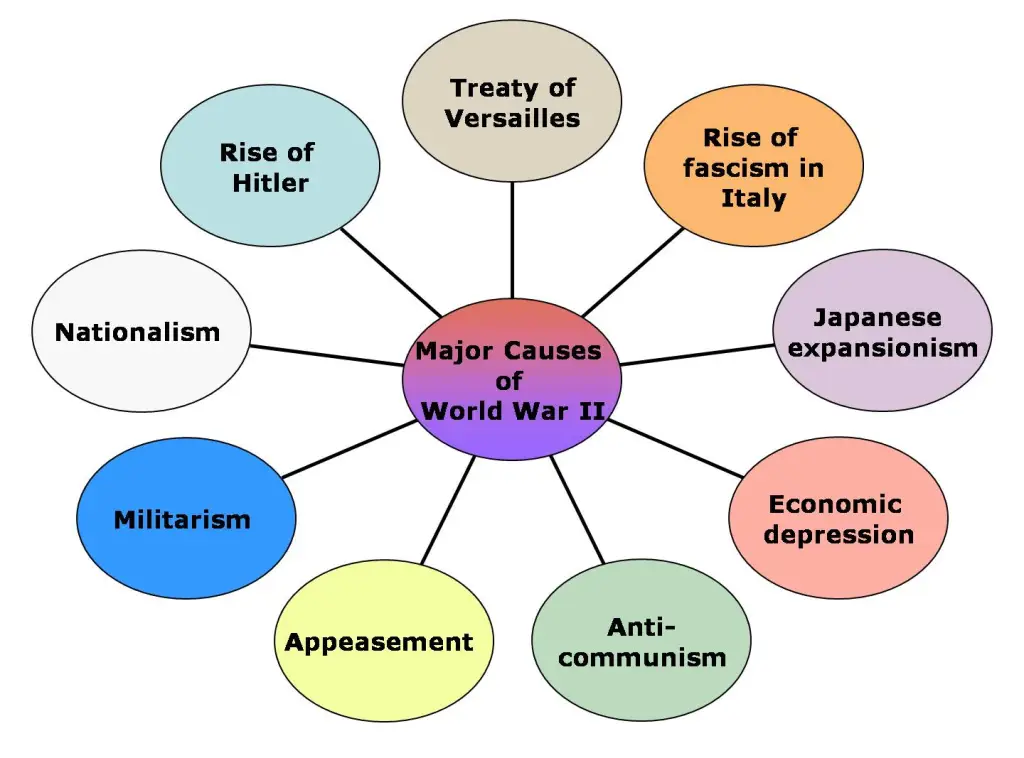
There were multitude of causes leading to the Second World War. Although the stage had been set since long, having numerous long-term causes, some events proved to be the last nail in the coffin and led to the immediate trigger of the war. The specific causes could be dichotomized into long-term and immediate as under:
Long-term Causes
- Harsh and Unfair Post War Treaty: The manipulated peace settlements after the First World War and the exuberant war reparations imposed on the defeated states, especially Germany, engendered the feeling of humiliation and loss of prestige. The Dictated Peace , as called upon by the Treaty of Versailles, made far reaching territorial readjustments which satisfied only victors while leaving others highly dissatisfied. It also crippled Germany and its allies. The western desires were, however, dictated on Germany, outcomes of which would surface just in two decades, leading to another and more devastating world war.
- Failure of League of Nations to Fullfil its Mandate: The League of Nations was constituted in 1919-20 (Paris
Peace Conference) so as to provide a platform for disputes resolution and to avoid another world war. The failure of its mandate could be regarded as one of the most important reasons behind the Second World War.- Its debacle as an International peacekeeper and in efforts towards disarmament, etc., gave way to the catastrophe of the Second World War. The incompetency of the League during the invasion of Manchuria, Italian aggression against Ethiopia, Abyssinian crisis, etc., undermined its authority and mandate as an International peacekeeper. US’s coming out of the League also gave a big blow to the legitimacy of the League.
- Inefficient Refugee Resettlement Post-World War I: The failure of Paris Peace Conference in looking after the question of displaced populations was also one of the reasons. This led to rise of discontent among the minorities in several states. This also, in a way or the other, created problems in the already deteriorating political arenas of the European states. Hitler, for instance, justified and pursued expansionist foreign policy in order to accommodate all the Germans of the world (including those in Poland, Czechoslovakia and Austria) and wanted to make a Great Germany.
- Rise of Extremist Ideology: The First World War inevitably sowed the seeds of political, economic, and, social instability in Europe, paving the way for the dictatorial rules in several parts of Europe and across the world. These conditions led to the emergence of most barbaric dictatorial regime i.e ., Fascism and Nazism. They spread the propaganda of revival of the greatness of their ancient states (like ancient Rome, Teutonic order, etc.), regain of the loss of so called prestige after the First World War, etc. They also embraced war and preached violence. The most extreme form of Fascism, called Nazism, was developed in Germany.
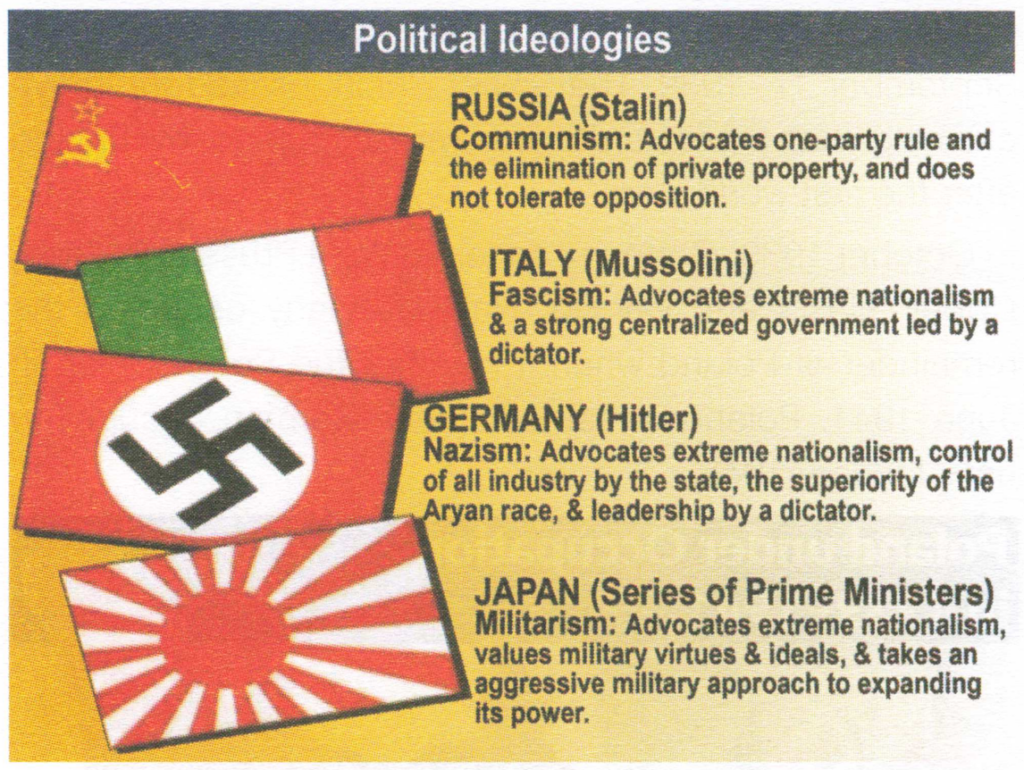
- Economy Failure: The Great Depression of 1929 also added fuel to the pyre of world peace. It maimed the already crippled economies of the war ravaged nations of Europe. The defeated countries bore the dual brunt of war reparations as well as that of the Great Depression.
- New Wave of Imperial Expansion: The economic miseries also cleared the ways for the demagogic, hence dictatorial leaders like Mussolini, Hitler, etc. These conditions rather proved to be a fertile ground for the coming up of such fascist parties. These fascist states, under miserable economic conditions, resorted to imperialist and expansionist policies. Most of the interventions and invasions during 1919-39 were solely guided by economic ends. The fascist rulers saw the solution of their economic problems in military conquests and military expansion. The formation of Rome-Berlin Axis was an evident outcome of all this.
- Aggressive Japan International Policy: Japan’s military fascism and its expansionist desires (especially along Asia-Pacific) was also one of reasons for the Second World War. Its ambitions got further impetus after the First World War as it also decided to expand its military strength. The military secured a stronghold in the political realm of Japan and justified war and aggressive territorial expansion.
- Ambiguity Over Multiple Alliances: Various overt and covert alliances were also formed, as before WWI, from 1919 to 1939. Several axes, like Rome-Berlin axis, anti-Comintern pact, etc., were formed. Result of which was that the world, by 1937, got divided into two rival alliance systems- The Rome-Berlin-Tokyo Axis, and, the anti-Axis alliance system.
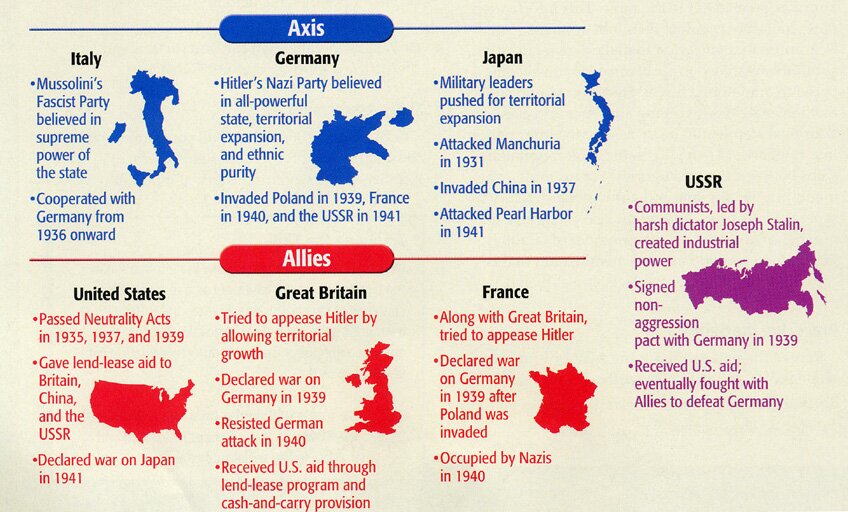
- Liberal Policies: The most depressing was the irrational policy of Appeasement followed by the west. They followed this policy of Appeasement in order to save them from any upcoming social and communist revolution. They saw the growing fascist states as safety valves against such revolutions. This policy of Appeasement, in some way or the other, cemented the irrational belief of indomitability of fascist forces. It skyrocketed the confidence of the fascists against the whole world. This was evident from the statement of Hitler after the meeting at Munich (1938 Munich Pact). Addressing his Generals, he said, ‘Our enemies are little worms, I saw them at Munich’.
Immediate Cause
- The above discussed causes were slowly, but steadily, giving rise to, and, continuously aggravating the overall conditions which led to history’s most devastating war. But, the German invasion of Poland in September 1939 gave immediate trigger to the outbreak of the second world war. Following this, Britain and France got involved by declaring war on Germany, and soon Europe and the world plunged into the war.
Events of World War 2
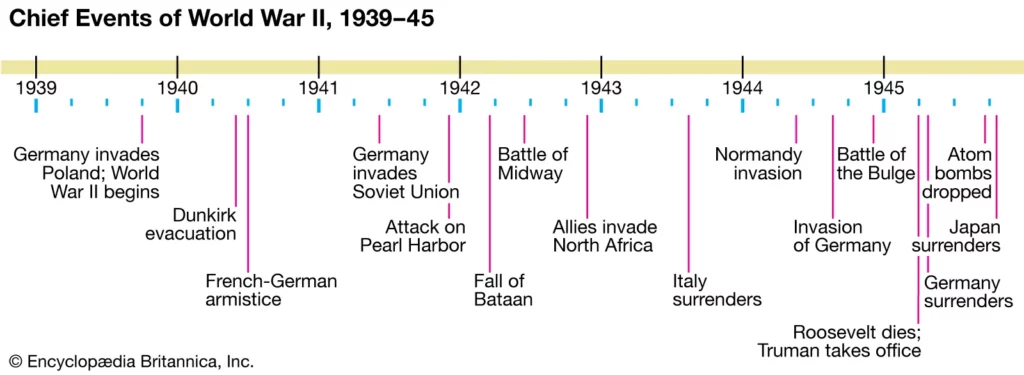
Polish Occupation
- Under the Treaty of Versailles, Poland received former German provinces of West Prussia, Poznan and Upper Silesia after the First World War. Such territorial reorganizations after the first world war left Germany, among others, highly dissatisfied. Germans, especially Hitler after coming to power, wanted to unite former territories of Germany under one Great Germany. He moved towards his goal unopposed and swiftly. For the annexation of Poland, he signed a non-aggression pact (Ribbentrop-Molotov pact) with the Soviet Union. In order to neutralize any possibility of a French-Polish military alliance against Germany, Hitler had already signed a nonaggression pact with Poland in 1934.
- The Ribbentrop-Molotov pact, which stated that Poland was to be partitioned between these two powers, enabled Germany to attack Poland unopposed. Soviet leader Joseph Stalin also signed this pact in order to keep his nation on peaceful terms with Nazi Germany, while earning time to build up the Soviet military.
- On September 1, 1939, Germany invaded Poland. The Polish army was defeated only within weeks. On September 27, 1939, Warsaw also fell under the Nazis. Britain and France, under their obligation to Poland, declared war on Germany on Sept. 3, 1939.
- The Soviet Union invaded eastern Poland (comprising erstwhile territorial parts of Ukraine and Byelorussia) on September 17, 1939. The Soviet Union justified the move claiming that these territories were occupied by Poland after the first world war.
- In October 1939, Germany annexed West Prussia, Poznan, Upper Silesia and Danzig. Nazi Germany occupied the remainder of Poland when it invaded the Soviet Union in June 1941. Poland remained under German occupation until January 1945.
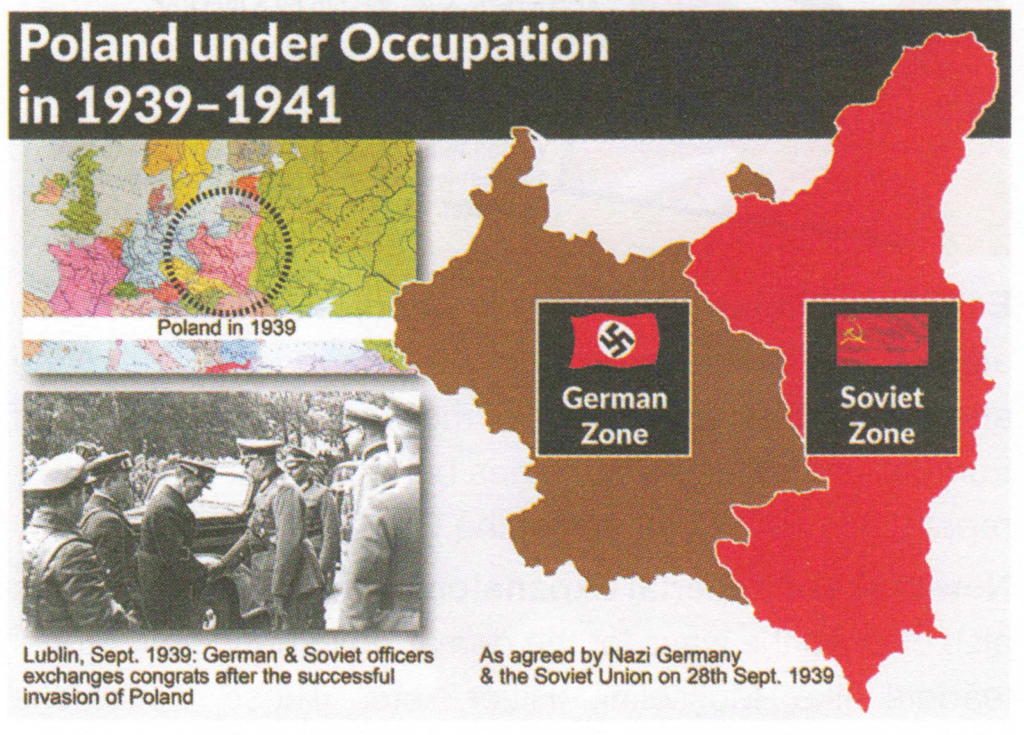
Conquest of Denmark and Norway
- German economy, back then, was largely dependent on the iron ore imports from Sweden. During summers, iron ores were transported directly to Germany via North-South railways (which were clear of snow in summers) and then Swedish Baltic ports (which were unfreezed in summers). But in winters, the iron ores, from Sweden to Germany, first move westward over land route into Norway and then Southward to Germany through Sea route.
- Meanwhile, Britain, under Winston Churchill, mined the Norwegian coastal waters to deter German transports in April In order to save its iron ore imports from Allies attack, Hitler invaded Norway and Denmark (under a joint operation Weserubung). Denmark surrendered without fighting and Norway was conquered with the aid of Norwegian fascists (led by Vidkun Quisling). These occupations gave advantage to the fascist Germany by gaining some important naval and air bases in northern Europe.
Battle of Britain
- The Battle of Britain was a major clash between the Air Force of Germany (Luftwaffe) and the Royal Air Force of Britain over the skies of UK during the second half of 1940. In this war, the Royal Air Force successfully defended UK from the air attack of the Nazi Germany.
- After the defeat of France in June 1940, Britain was left as the sole power against Germany, which had, by that time, conquered most of the western Europe. Germany was now eyeing towards Britain for its next conquest and made a plan named ‘Sea Lion’.
- It launched a joint attack on the ports and the air bases of Britain in order to cross the English Channel. But,
because Germans found the Royal Air Force formidable, they channelized their efforts in kneeling down the Royal Air Force first. Germany started bombing important cities of Britain including London. Britain, in return, raided and bombed several cities of Germany. - Apart from the outstanding zeal of the Royal Air Force, the vibrant speeches and oratory of the then British Prime Minister, Sir Winston Leonard Spencer – Churchill, played subtle and a very pristine role. Through his outstanding speeches, he kept up the morale of the people of Britain high. The name, Battle of Britain, also came from his speech to the British Flouse of Commons (June 1940): The Battle of France is over. I expect the Battle of Britain is about to begin’. The Battle of Britain was probably the first major turning point of the war. The Germans were checked for the first time, thus, demonstrating that they were not invincible and could be defeated.
Other Theatres of War
- Slowly, but steadily, war spread to other parts of Europe and that of the world. Germany, Italy, and, Japan, sharing basic thoughts of aggressive expansionism and establishing their own order(s) in the respective continental parts of the globe came together by signing a Tripartite pact in September 1940. Germany and Italy recognized Japan’s claim over whole of Asia and Japan, in turn, acknowledged German and Italian authority over Europe.
- States like Hungary, Romania, Slovakia and Bulgaria also joined the Tripartite pact in 1940-41. Troops were infused into the territories of these states. Some historians, however, are of the view that infusion of troops into these territories was a prelude to the German plans to conquer the Soviet Union in 1940. German troops also annexed Yugoslavia and Greece, and only Britain and the Soviet Union were left in Europe.
- Concurrently, British colonies in Africa, like Somaliland and Sudan, were also invaded by Italy (whose next target was Egypt). By the end of 1940, British won back all its African colonies from Italy, except Libya. In 1941, Italy, aided by German troops, again launched an attack against Britain in Libya.
German Invasion of USSR
- In June 1941, Nazi Germany launched a surprise massive attack on the Soviet Union under an operation named Operation Barbarossa. The invasion was launched along a stretch of more than 3000 km from the North Cape to the Black Sea. But the failure of Operation Barbarossa proved to be a turning point for the second world war and the decline of Germany started from that point of time.
- The fascism, since its inception, was standing against the workers’ and peasants’ organization, the socialists, and, the communists. Wherever they rose, their main target were people from these groups. Adolf Hitler was rather more clear and often claimed that his real war would be waged against the Soviet Union. Fie had several other reasons as to why he eyed the Soviet Union. Firstly, because of the Soviet Union being a resource rich country, and, secondly, because he wanted to provide living space(s) to the Germans (Reich) i.e., Lebensraum.
- Some historians are also of the view that he wanted to accommodate the Dutch and the British too, considering them racially a proximate to Aryans, and Europeanize and weed out the Asian character of the Soviet Union. He also had architectural plans of how the captured territory of the Soviet Union, for Lebensraum, would be developed. He was also determined to enslave the Slavic population and exterminate the Jews.
- In order to fulfil these wishes, Hitler planned to acquire the Soviet Union before the onset of winters of 1941 (conquer within few weeks). Within a week of the German attack on the Soviet Union (in June 1941), German forces, aided by air attacks, advanced deep into the Soviet territory. The German forces occupied Kiev, Smolensk and Odessa.
- Meanwhile, the German army was also facing serious paucity of the weapons and ammunitions, and, were not well equipped for a sustained war (as per Hitler’s plan, the war has to be short-lived). These flaws, coupled with the knocking winters, proved disastrous for the German army. By early October, Moscow seemed open to German advance. However, the winter and heavy rains thwarted the German attempt to capture Moscow and gave a huge setback to it.
- The German soldiers, having no winter clothes, were also suffering as temperature started falling. The terrifying temperature of about – 40°C, by November, left the German equipment worthless. Aided by all this, the Soviet army launched a counter-attack on the German forces which led to retreat of the German forces from Moscow.
United States Entry into the War
- Till December 1941, US abstained from direct participation in the Second World War. However, it was involved with Britain and the Soviet Union (at the end of 1941) in their conflict against the Axis powers. In December 1941, with the attack on a US naval base at Pearl Harbor in Hawaii by Japan, US declared war on Japan, and later on, Germany and Italy.
- After the Great Depression and during the beginning of the Second World War, US had entered a period of isolation, viewing the conflict as Europe’s problem. It decided to stay away from any direct or indirect intervention in the conflict. It also supported the irrational ‘policy of Appeasement’ followed by Britain and France.
- The US was also under the pressure of Americans, who, despite of their sympathy to Britain, never wanted the US to enter the war. But even after its reluctance to join any war effort, US took some minimal steps like opposing Japan’s invasion of Manchuria.
- Tensions between US and Japan also escalated during this period. Subsequently, with the situation in Europe growing increasingly dire, US began to slowly edge towards the war. It started aiding Britain with its supplies of ammunitions (by selling it to them) and when, in 1941, Britain faced paucity of funds to purchase such ammunitions, US started leasing out armaments. These lending of ammunitions were banked upon a law passed by the US congress and came to be known as ‘lend-lease system’. This lend – lease system was also extended to the Soviet Union after its German invasion (in 1941).
- Moreover, sensing the growing danger, the then US President Franklin D. Roosevelt and British Prime Minister Winston Churchill came up with the Atlantic Charter, 1941.
- This Charter, although not established US’s entry in the war, formulated certain principles for a better future for the world and called for the complete and final destruction of the Nazi tyranny.
- It also declared that Britain and the US respect the rights of all people to choose their form of government.
- The Soviet Union also joined the charter later on. Subsequent to all these developments, came the immediate trigger which prompted US to directly enter the war. Japan always had desires over Asia-Pacific and after Vietnam’s occupation by mid of 1941, Japan attacked a US naval base at Pearl Harbor in Hawaii on December 7, 1941. Apart from heavy losses inflicted upon US, the event, though, surprised the US. It always thought that Japan’s targets, at most, would be Dutch and British colonies in that area. The very next day (December 8, 1941), US launched a counter – attack on Japan, declaring war on it. Germany and Italy, in turn, declared war on US.
Battle of Stalingrad
- The battle of Stalingrad, considered to be the greatest battle of the Second World War or the greatest battle of the Soviet great patriotic war, was fought between Nazi Germany and Soviet Union. This war happened over the question of German attack on the southern Soviet state of Stalingrad (along the banks of Volga river) after German retreat and debacle from Moscow. It hindered German advance into the Soviet Union and marked the inclination of war in favor of the Allies.
- After their fiasco at Moscow, German army advanced deep into the oilfields of Caucasus (early 1942). Then Hitler decided to exterminate the Soviet army and launched an offensive on Stalingrad in July 1942. Stalingrad was a large industrial production hub of armaments and tractors. Annexing it would cut Soviet transport links with southern Russia.
- Moreover, it would aid the German army in their drive in Caucasus. Lastly, but importantly, capturing Stalingrad (which bore the name of Soviet leader Joseph Stalin) would serve as a propaganda victory for Adolf Hitler. By mid-November 1942, the German troops took a great deal of the city. Harsh fighting was going on for every nook and cranny of the city. At the end of November, the German troops were surrounded by the Soviet army, hence, cutting supplies for them.
- The German troops, after a devastating experience in Operation Barbarossa, again plunged to huge problems of paucity of supplies, weapons, and also that of the winters. Finally, after a fierce battle, the German army surrendered on January 31, 1943.
- The failure at Stalingrad was a great humiliation for Hitler. His legitimacy, amongst his Generals, also fell after the Soviet victory. Stalin, on the other hand, gained confidence in his military. Several other skirmishes, like the Battle of Kursk (mid 1943), with consequent German defeats followed.
War in North Africa and Pacific
North Africa
- Italy invaded British colonies in Africa like Somaliland and Sudan and was eying on Egypt’s invasion. In 1941, Italy, aided by the German troops, attacked Britain in Libya. In 1942, the fascist powers launched another attack over British forces in Egypt. As evident, the fascist powers’ series of successes and offensives reached its peak and from 1943, period of defeats was set in motion.
- Britain won back its colonies in North Africa except Libya. It imposed yet another humiliating defeat on German troops at the Battle of El Alamein (November 1942). Apart from saving their colonies, the combined forces of US and Britain raided areas under control of the allies of Germany.
- The US and British troops landed on the Atlantic coast of Morocco and in Algeria, both of which were under Vichy France (France under Nazi occupation). The British forces, in addition to the free French forces, captured the Vichy French colonies of Syria and Lebanon. The French army in Vichy France, after sometime, joined the Allied forces. Sensing the danger, Germany started sending reinforcements to areas under its control, like Tunisia (a French colony). Finally, by mid-1943, the fascist forces were driven away from North Africa after British and American attack on Tunisia.
Pacific
- In the Pacific, mainly Japan and US were at loggerheads. Numerous naval battles took place between the US and Japan in the Pacific. Although the Allies were successful in regaining their colonies there, but, they got negligible success in China. Japanese aggression in China continued. The Allies were pursuing some covert options in China, like sending supplies to Chiang Kai Shek, but no substantial attack against Japan, in China, could be launched.
Allied Victory
- As mentioned earlier, the series of gradual victories of the Allied forces were set in motion by 1943. The Allies’ victories in the North Africa and Pacific has already been illustrated. The Nazi German suffered a big blow in the Soviet wars. Italy also witnessed several humiliating defeats.
- The US and Britain prioritized their attacks against the fascists and postponed their offensives in the western Europe to 1944. Meanwhile, they concentrated in North Africa and Pacific and even after Soviet request to open a ‘Second Front’ by invading France, in July 1941, they diverted most of their offensives towards North Africa and Pacific. Also, huge frustration, because of slew of humiliating defeats, was simmering amongst the armed forces in Italy, by mid-1943.
- Taking note of the situations in the Soviet and Northern Africa the Allies invaded Sicily in July 1943. The Italian forces surrendered and Mussolini was dismissed later on, thus, paving way for a new government. The Allied forces finally cowed down Italy in September 1943 by invading southern Italy. Only a few days later, the German forces launched an attack over Italy, rescued Mussolini from confinement and helped him in setting up a protege government in northern Italy.
- The Mussolini government, under the tutelage of Nazi Germany, faced stiff popular resistance. Southern Italy, after getting a new government, also declared war on northern Italy. By June 1944, the Allied troops had liberated many Italian cities, most importantly, Rome. Meanwhile, several uprisings accompanied, and, on April 28, 1945, Mussolini was apprehended and executed, marking the end of fascism in Italy.
- By around 1944, the fascist forces were forced out of the Soviet Union, Greece, Yugoslavia, Albania and the eastern European states of Poland, Romania, Bulgaria and Czechoslovakia. The fascist powers in other states, like Finland, were also defeated at the hands of the Soviet Union. In June 1944, the Allied forces opened offensive (‘Second Front’) in western Europe (which was postponed earlier).
- The first Allied troops arrived at the beaches of Normandy, north coastal France, on June 6, 1944 (boasted as the ‘D-day’). Within four months, France, Luxembourg, and Belgium were emancipated from the fascist control.
- In December 1944, yet another drive against Germany was opened in the Ardennes region of Belgium, leading to the Battle of Bulge. With the Soviet attack on the eastern front in January 1945, Germany was compelled to channelize all its troops to the east. Hence, troops were also withdrawn from Ardennes and the Battle of Bulge ended in January 1945.
Surrender of Germany
- By early 1945, Nazi Germany got trapped from both the eastern as well as the western front. One by one, cities like Warsaw, Budapest, Vienna, etc., were liberated. Large parts of western Germany were annexed by the Allied forces, concurrently, the Soviet troops encircled Berlin by April 25, 1945. Adolf Hitler committed suicide on April 30, 1945, and after few skirmishes, Germany was cowed down on May 7, 1945.
Surrender of Japan
- After the war ended in Europe by the surrender of Germany, and, consequent liberation of Czechoslovakia (May 11, 1945), the only opponent of Allies left was Imperial Japan. It was still waging wars in several areas of Asia Pacific. Japan’s defeat seemed inevitable by the summer of 1945. The Japanese navy and air force were extinguished.
- Japan’s economy also got wrecked by the bombing of its several cities and naval blockade by the Allies. By June 1945, Japanese island of Okinawa was captured by the US. On July 26, 1945, the United States issued Potsdam Declaration or the proclamation defining terms for Japanese surrender, declining which would mean ‘the inevitable and complete destruction of the Japanese armed forces and just as inevitable the utter devastation of the Japanese homeland’.
- Two days later, Japanese Prime Minister Kantaro Suzuki, declining it, said that his government was not paying heed the declaration. This led US to drop an atomic bomb on the Japanese city of Hiroshima (August 6, 1945). In August 1945, the Soviet Union declared war on Japan, attacked Manchuria, and another atom bomb was dropped by the US on the Japanese city of Nagasaki (just three days after the first bombing). On September 2, 1945, the second world war ended with the surrender of Japan.
Atomic Bombs
- Around 2,00,000 people were killed with the first ever atomic bombing at the Japanese city of Hiroshima. Out of this, 80,000 were killed instantly. Just 3 days after the odious event of bombing at Hiroshima, another Japanese city, Nagasaki, was bombed killing 70,000 people instantly.
- These bombings were detestable, firstly, over the fact of elephantine numbers of those killed, and, secondly, because of the use of a novel weapon of mass destruction.
- The then US President Harry S. Truman and other protagonists backed the nuclear detonation by a rhetoric that, ‘had Japan not been stopped, its furtherance would have resulted in up to 1 million casualties’. Several historians contest such statements by saying that Japan was in no position to sustain a protracted war.
Impacts of World War II
- The second world war was a transformative event of the 20th century. As discussed earlier, the second world war marked the weeding out of old world powers and emergence of new ones i.e ., US and USSR. In a nutshell, it shifted the power fulcrum from Europe to the US and the Soviet Union.
- According to a calculation, 62-78 million people or 3% of the world population lost their lives during the Second World War. About half of them were civilians. Economically, it also proved far more devastating than the first world war. Huge loss of property, viz. roads, infrastructure, industries, etc., accompanied. Notwithstanding who was a victor or a loser, the level of ruination was nearly same. Most of the cities of Europe were reduced to rubble.
- Britain was bankrupted and the Soviet Union was suffering badly, with innumerable but many multifaceted losses. Institutions like IMF (International Monetary Fund, 1944) and GATT (General Agreement on Tariffs and Trade, 1947) came into existence so as to reconstruct international payment system and promote international trade and increase cooperation respectively.
- Politically also, it was differentiated from the first world war, as clear from a statement:
- ‘At the conclusion of the First World War; it was borders that were invented and adjusted, while people were on the whole left in place. After 1945, what happened was rather the opposite: with one major exception boundaries stayed broadly intact and people were moved instead’. – Tony Judt.
- Only few boundary readjustments were made, as against after the first world war. These boundary settlements were decided in the Yalta Conference, 1945. Apart from boundary settlement of Poland, German fate, to an extent, was also decided and Germany was temporarily divided into four zones. Although increasing east-west divide in coming years (1949) led to a permanent division of Germany. It was also decided that the eastern European states of Poland, Hungary, Bulgaria, and Czechoslovakia would be conducting free elections.
- Over and above all, a major outcome of the Second World War was coming up of the US and USSR as two new dominant world powers. Post-war settlements were to be decided between these two world powers and that became a trigger in bolstering future tensions between the two. In the backdrop of already existing extreme differences between the ideologies of these two world powers (Capitalist and Communist), further tensions arose and led to the division of Europe into two camps. It also sowed the seeds of the ‘Cold War’, offshoots of which is seen and felt even today.
- Besides all such negatives, the period of second world war engendered a fervor of democracy and strengthened the freedom movements all across the globe. Many countries got freedom and people rose in their fight against atrocious colonialism. Japan’s imperialism was ended in Asia with Japan temporarily placed under the US. The war weakened the imperialist nations cementing the national movements in Asia and Africa and countries like India, Sri Lanka, Egypt, Cambodia, etc., got freedom after few years of struggle after the Second World War.
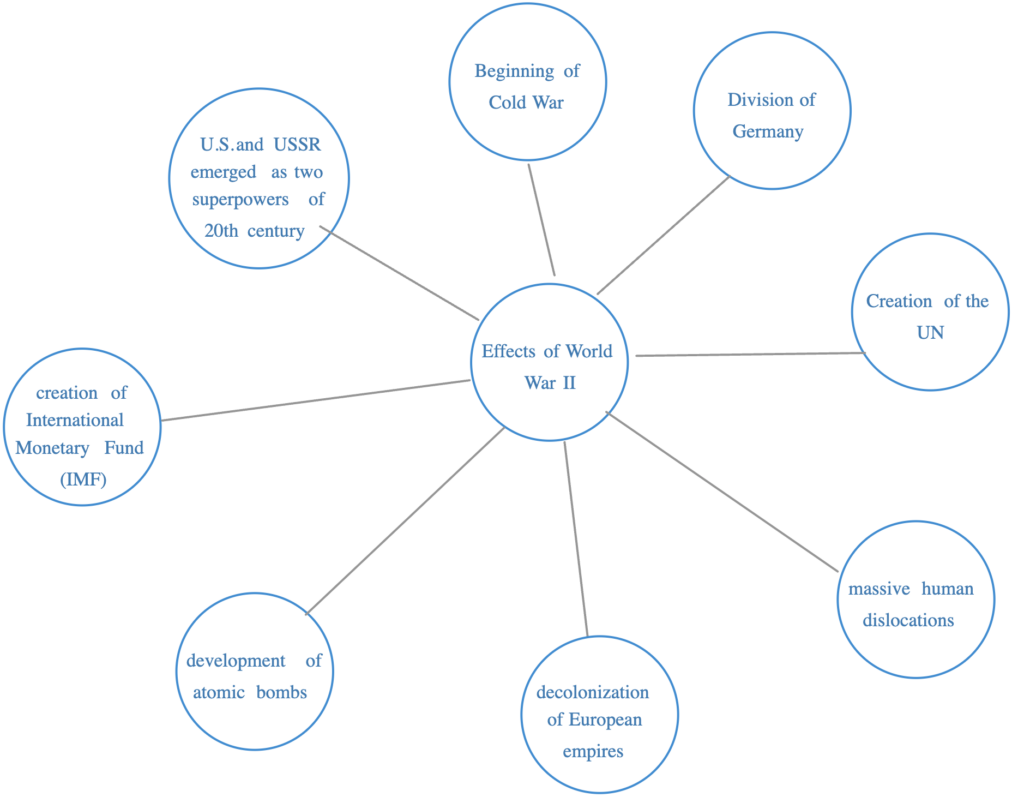
WW II: A Critical Analysis
- The second world war was the most cataclysmic event the world has witnessed till date. With countless deaths, myriad loss of property, mass genocide and famine to the use of the first ever nuclear bombs, it has a very complex set of outcomes.
- It also gave a new concept of war in a very novel sense, the Cold war, where no direct or overt military clashes happen but a very fierce and covert propaganda is the weapon. The world during and after the second world war, in a very substantial sense, had a huge impact the dynamics of the international relations.
- The tussle in the United Nations, especially between US and Russia, the relations between US and Japan, multifarious instabilities in the Middle East, the race in the central Asia, the drive against nuclear non-proliferation and power dynamics across the Asia-Pacific are all the after-effects of the Second World War. The second world war is also regarded, by many, as a ‘Good War’, but in a critical sense, this tag of a ‘Good War’ would just be a misnomer. Notwithstanding the outcomes of the Second World War were end of fascism and imperialism and spread of a democratic fervor, the events which led to the war and events preceding the war disrupts this tag of a ‘Good War’.
- One should not overlook the fact that from the issues like irrational policies of appeasement by Britain and France, inactivity of US, to the most shameful event of betrayal with Czechoslovakia (in the Munich Pact), preceded the Second World War.
- The Soviet Union, only in order to do away with its own fear from Nazi Germany, signed a non-aggression pact with Germany. Had the states jointly stood against the fascist barbarities, with suppressing their personal irrational interests, the story would have been vastly different. Even during the war, these nations were not free from such untenable thoughts, as, when the Soviet Union had appealed to Britain to open a ‘Second Front’ against Germany in the west Europe, Britain denied to do so.
- It was rather inevitable for the members of the ‘Allied nations’ to stand against the Axis power. Willy nilly, they stood together in order to fight fascism, and won. It led to the end of fascism, colonialism, and established many new independent nations. But that’s only a meagre part of the story. Just after four years i.e., in 1949, divisions again rose its head and Europe got divided into two camps by the ‘iron curtain’. The US and USSR again came at loggerheads and further developments led to the cold war, which still exists to an extent.
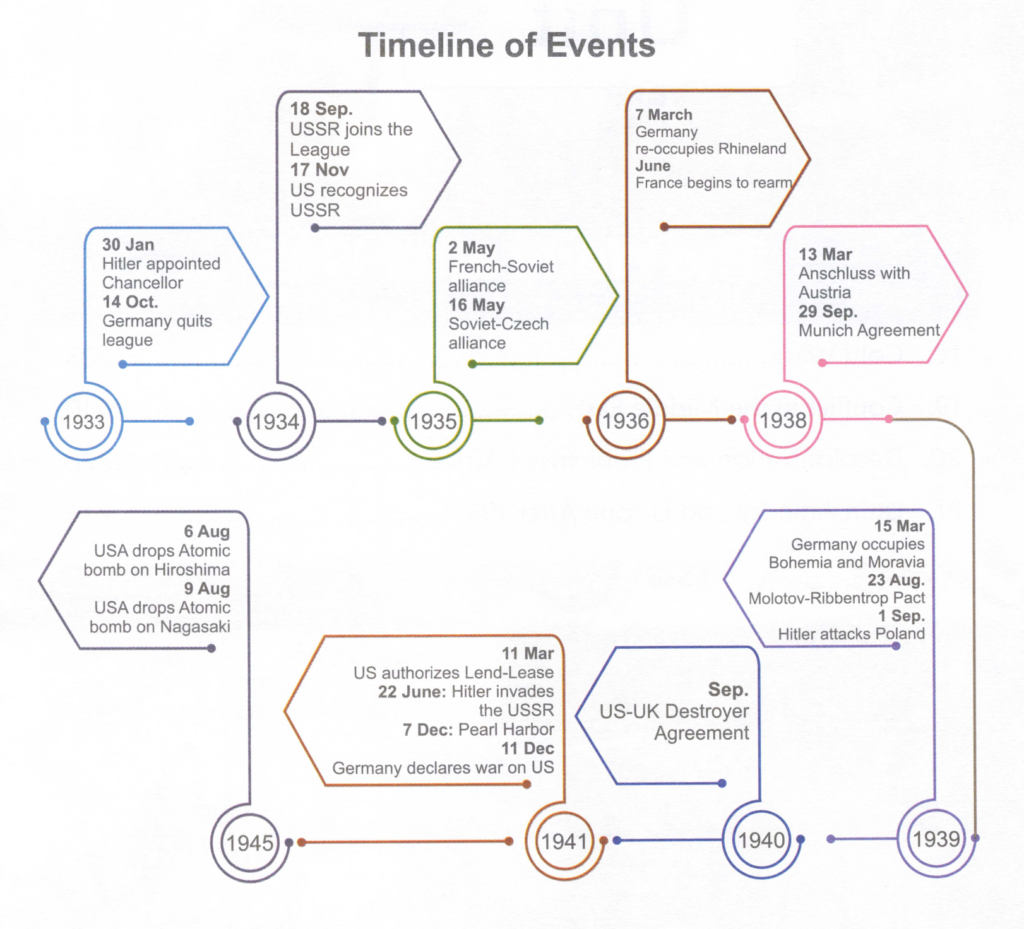
UN Charter
- The UN Charter, signed on June 26, 1945, at San Francisco United States, formed the bedrock of the United Nations.
- It elucidated the purposes (viz . to maintain international peace and security, to develop friendly relations among nations, etc .) and structure (organs having: A General Assembly, a Security Council, an Economic and Social Council, a Trusteeship Council, a Secretariat) of the United Nations.
- It also envisioned organizations like UNESCO (United Nations Educational, Scientific and Cultural Organization) and WHO (World Health Organization). The formation of United Nations, after the failure and incapacity of the League of Nations, was a landmark and a watershed event.
